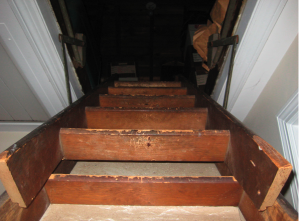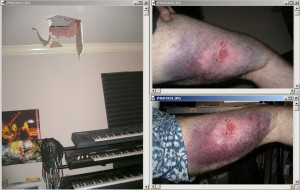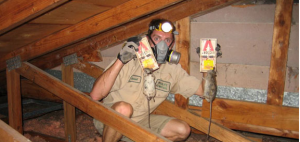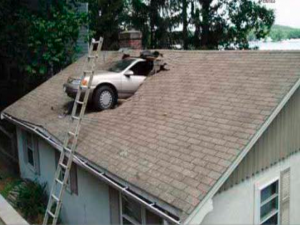 There is a hidden danger in almost every single attic in the world, this insidious enemy cannot be controlled with sprays, powders, baits or any of the most sophisticated pest control equipment ever designed.
There is a hidden danger in almost every single attic in the world, this insidious enemy cannot be controlled with sprays, powders, baits or any of the most sophisticated pest control equipment ever designed.
This infestation can affect the do it yourself homeowner and the professional pest control professional alike. Most often it strikes when one has no idea it’s there, they may feel completely in control and when everything seems safe it strikes. Men and women are often seriously hurt while some skate by with just a scratch and a scare. The danger in the attic is not an insect or vicious animal lurking in the shadows but can be just as surprising.
Every year 1000’s of people performing pest control in attics fall through the ceilings because they  are unfamiliar with how to safely traverse on it’s rafters. Most times they think that the drywall is a solid surface and walk as if they were on a tiled kitchen floor. Some fall all the way to the surface below while others might just stick a foot through the drywall before they catch themselves. Most attics aren’t made to walk in and insulation, duct work and low clearances just increase the difficulty. If this isn’t bad enough add to it the fact that an attic can reach temperatures of 120 degrees on a hot summer day. I have to go into attics all the time and believe me I don’t look forward to it.
are unfamiliar with how to safely traverse on it’s rafters. Most times they think that the drywall is a solid surface and walk as if they were on a tiled kitchen floor. Some fall all the way to the surface below while others might just stick a foot through the drywall before they catch themselves. Most attics aren’t made to walk in and insulation, duct work and low clearances just increase the difficulty. If this isn’t bad enough add to it the fact that an attic can reach temperatures of 120 degrees on a hot summer day. I have to go into attics all the time and believe me I don’t look forward to it.
Tips on moving through an attic safely
- Don’t be in a hurry, rushing through an attic will almost always end badly
- Try to only go into the attic in the cool of the morning or a few hours after sundown
- Have plenty of light, headlamps are best or a bright handheld
- Keep at least one hand secured to a rafter with every move
- Never guess that you’re placing your feet in a stable place, know it
- Carry any equipment on a belt or backpack or move it ahead each time you stop
This list should help you but I’ll explain how I do it and perhaps this will give you a better mind picture of each safety tip listed.
 In my line of work I can’t always pick and choose when I have to crawl into an attic so there are times when it is extremely hot. If for some reason my work will carry me to the far end and away from the entry I have been known to reschedule services due to the risk. I’m told that in the high temperatures of an attic or any extreme heat situation you have about 8 minutes before your body begins to over heat and bad things begin to happen. I usually carry a flashlight and wear a clip on head lamp, this way if I need two hands I slip the handheld in my back pocket and can still see. If it is a mouse or rat job I’m doing I’ll put my traps and bait in a plastic bag and tie it to my belt. Anything heavier or more bulky I just inch it ahead each time I stop then securely move forward and reach behind and move it again. Secure footing is almost always hidden beneath insulation but the 2×4’s you need to stand on are lined up with the rafters by you’re head so you should use that for reference. Place your foot on the 2×4 and tap a little to ‘feel’ the board with your foot, only put full pressure when you know you are on it. I never take a step without one hand on a rafter, this means I keep one hand free at all times with no equipment or flashlight to hold. When you’ve stopped to do your work maintain one hand on a rafter as much as possible. I will squat down and lean on a truss for balance and support. When your task is done simply follow the same procedure to get back to the entry.
In my line of work I can’t always pick and choose when I have to crawl into an attic so there are times when it is extremely hot. If for some reason my work will carry me to the far end and away from the entry I have been known to reschedule services due to the risk. I’m told that in the high temperatures of an attic or any extreme heat situation you have about 8 minutes before your body begins to over heat and bad things begin to happen. I usually carry a flashlight and wear a clip on head lamp, this way if I need two hands I slip the handheld in my back pocket and can still see. If it is a mouse or rat job I’m doing I’ll put my traps and bait in a plastic bag and tie it to my belt. Anything heavier or more bulky I just inch it ahead each time I stop then securely move forward and reach behind and move it again. Secure footing is almost always hidden beneath insulation but the 2×4’s you need to stand on are lined up with the rafters by you’re head so you should use that for reference. Place your foot on the 2×4 and tap a little to ‘feel’ the board with your foot, only put full pressure when you know you are on it. I never take a step without one hand on a rafter, this means I keep one hand free at all times with no equipment or flashlight to hold. When you’ve stopped to do your work maintain one hand on a rafter as much as possible. I will squat down and lean on a truss for balance and support. When your task is done simply follow the same procedure to get back to the entry.
If you ever have the need to treat an attic for any pest control treatment make sure you are careful.  Perhaps for most it would be better to hire a professional who has the equipment and can make short work of it. But if you must venture in to the dark abyss remember it’s kind of like driving a car; to do it safely you must follow the rules of the road.
Perhaps for most it would be better to hire a professional who has the equipment and can make short work of it. But if you must venture in to the dark abyss remember it’s kind of like driving a car; to do it safely you must follow the rules of the road.




